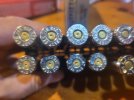Greetings, I am breaking in a Winchester Model 70 Alaskan, 375 H&H. This gun is a strong candidate for a back up on an upcoming CO elk hunt this fall. I will soon do some load tuning but now have an issue with misfires. I have discharged 60 rounds of Federal Premium, 300 gr Nosler Partition, with no issues. Best group is 1.7 MOA but am confident with hand loads that I can get it pretty close to 1 MOA. This weekend, I tried Hornady Outfitter 250 gr GMX. Of seven attempted firings, 3 were misfires. Hornady customer service looked at the attached pic and stated:
"Thanks for the inquiry. At first glance we notice that the pin strikes on the primers aren't centered on the primer and do appear a little shallow. We seat the primers slightly below flush about .005" to .007" but this increases the sensitivity of the primers. Currently we don't show any other known issues with that particular lot# at this time."
In the pic, the three misfires are on top, beside an unchambered round, four normal fired cases on the bottom. As you can see from Hornady, no consideration of the fact that the gun performed without issue with another type of ammo. Winchester said to go ahead and ship the gun to their service center in Missouri. However, I may consider having a local smith give it a look. I can also try another type of factory ammo (not cheap however these days, at 4+$ per round), or try some hand loads. Any thoughts or advice? I can also get the comparators out and compare head space/case length for fired and unfired cartridges with both ammo types on hand. Could the Hornady cases be a tad short, too much room in the chamber? Both types are nickel plated cases. Any similar experiences with Hornady Outfitter ammo (which they claim is durable and dependable enough for an outfitter to use).
Thanks in advance for your help.
"Thanks for the inquiry. At first glance we notice that the pin strikes on the primers aren't centered on the primer and do appear a little shallow. We seat the primers slightly below flush about .005" to .007" but this increases the sensitivity of the primers. Currently we don't show any other known issues with that particular lot# at this time."
In the pic, the three misfires are on top, beside an unchambered round, four normal fired cases on the bottom. As you can see from Hornady, no consideration of the fact that the gun performed without issue with another type of ammo. Winchester said to go ahead and ship the gun to their service center in Missouri. However, I may consider having a local smith give it a look. I can also try another type of factory ammo (not cheap however these days, at 4+$ per round), or try some hand loads. Any thoughts or advice? I can also get the comparators out and compare head space/case length for fired and unfired cartridges with both ammo types on hand. Could the Hornady cases be a tad short, too much room in the chamber? Both types are nickel plated cases. Any similar experiences with Hornady Outfitter ammo (which they claim is durable and dependable enough for an outfitter to use).
Thanks in advance for your help.

